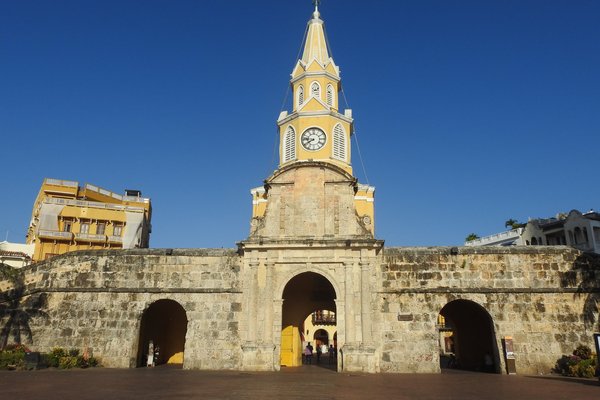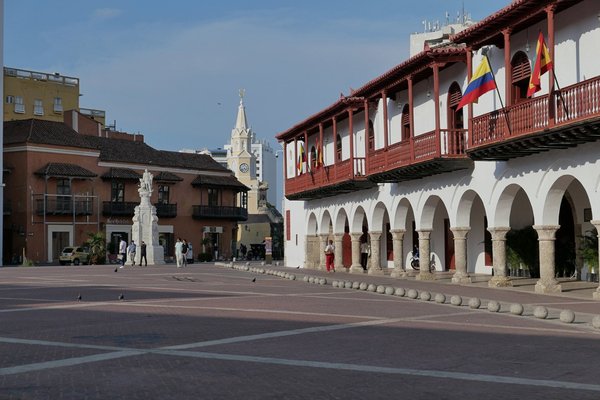Colombia
Cartagena
The Port, Fortresses and Group of Monuments, Cartagena, comprise a port city and the remains of military constructions built by the Spanish.
Cartagena de Indias holds a strategic position at the commercial maritime routes in the Caribbean. From the 16th century on, the Spanish designed a defense plan to protect the city against the plundering of English, Dutch and French pirates. It led to one of the most extensive and complete systems of military fortifications in South America. Within the walled city, three neighbourhoods developed with fine civil, religious and residential monuments.
Community Perspective: the overall feel is much more Caribbean than South American, and one can easily spend 2 days here walking the city walls and exploring the historic center. But “it is so fully geared to tourism that sooner or later you will get fed up with it”.
Site Info
Official Information
- Full Name
- Port, Fortresses and Group of Monuments, Cartagena (ID: 285)
- Country
- Colombia
- Status
-
Inscribed 1984
Site history
History of Cartagena
- 1984: Inscribed
- Inscribed
- Type
- Cultural
- Criteria
- iv
- vi
Links
- UNESCO
- whc.unesco.org
- Official
-
- cartagenadeindias.travel — Cartagena Travel
All Links
UNESCO.org
- whc.unesco.org — whc.unesco.org/
Official Website
- cartagenadeindias.travel — Cartagena Travel
News Article
- Dec. 22, 2025 aspenpublicradio.org — Cartagena's iconic horse carriages give way to electric buggies
Community Information
- Community Category
- Urban landscape: Colonial
- Urban landscape: Maritime
Travel Information
Recent Connections
-
No Map
-
Reportedly haunted locations
Ghostly sightings have been reported at…
-
Works by Nobel Prize winning authors
Marquez (1982) - Love in the time of Ch…
Connections of Cartagena
- Individual People
-
-
Visited by Alexander von Humboldt on his travels
Mar 30 - Apr 6 1801 -
Mapped or Illustrated by Blaeu
On top frieze of "Americae nova tabula" (1617)See luna.folger.edu
-
Sir Francis Drake
-
- Geography
- Trivia
-
-
Built or owned by Spanish
Cartagena was founded on June 1, 1533 by Spanish commander Pedro de Heredia, in the former location of the indigenous Caribbean Calamarí village (wiki) -
Hotels in Historic Buildings
Sofitel Santa Clara, in a former convent: "a jewel of 17th century colonial architecture which is on UNESCO's list of World Heritage Sites. Gabriel Garcia Marquez used this convent as the setting for one of his novels, 'Of Love and Other Demons'." (hotel website) -
Reportedly haunted locations
Ghostly sightings have been reported at the Naval Museum of the Caribbean, the former San Pablo Psychiatric Hospital and the Santa Clara Hotel. (link)
-
- History
-
-
Nine Years' War
The Raid on Cartagena, in April 1697 during the Nine Years' War, by Sir Bernard Desjean, Baron de Pointis and Jean Baptiste Ducasse was a severe blow to Cartagena. The Baron's forces included 22 large ships, 500 cannon, and 4000 troops, while Ducasse's forces consisted of 7 ships and 1,200 buccaneers. They quickly overwhelmed Sancho Jimeno de Orozco's force of 30 men in the San Luis de Bocachica fortification. Then, San Felipe de Barajas also fell and the city came under bombardment. The renowned Spanish defences were not what they had once been, and Pointis conquered both fortresses which defended Cartagena relatively easily, losing only sixty men. Between May 6 and 24, the French plundered the city, accumulating loot valued at ten to twenty million livres.See en.wikipedia.org
-
The Inquisition
Palace of the Inquisition Plaza de Bolivar -
Sieges and Battles
British 1741 (lifted); 1815, 4 month siege by Spain under Morillo who recaptured the city from the rebels who had declared independence in 1811
-
- Architecture
-
-
Coral Masonry
In Getsemani
-
- Damaged
-
-
Bombarded by the British Navy
March 1741 during the War of Jenkins Ear - with SpainSee en.wikipedia.org
-
- World Heritage Process
-
-
No Map
-
First inscriptions
Colombia 1984 -
Perfect Inscriptions
1984
-
- Religion and Belief
-
-
Jesuit Order
Iglesia de San Pedro Claver -
Cathedrals
San Pedro
-
- Human Activity
-
-
Piracy
"In the 16th century alone, Cartagena suffered five dreadful sieges by pirates, the most famous (or infamous) of which was that led by Sir Francis Drake." -
Slavery
"The Cartagena slave market, the largest in the New World, was held in the Plaza de los Coches" (orignally Plaza del Esclavo") -
Sea Ports
-
- Constructions
-
-
Walled cities
-
Equestrian Statues
Simon Bolivar (1900), Plaza de Bolivar. The plaza was originally the "Plaza de la Catedral" and later the "Plaza de la Inquisicion". It was remodelled as a park and renamed in 1896 and the statue of Bolivar himself added in 1900 -
Clock Tower
Puerta del Reloj - early 18th century, converted from a bridge gateSee en.wikipedia.org
-
Theatres and Opera Houses
Teatro HerediaSee es.wikipedia.org
-
- WHS on Other Lists
-
-
Memory of the World
Negros y Esclavos archives (2005) details the development of the slave trade in Cartagena (they are now in the National Archive in Bogota) -
World Monuments Watch (past)
Fortresses of San Fernando/San Jose (Concern over impact on structures of planned deepening of water channel for ships) (2010)
-
- Timeline
-
-
Built in the 16th century
Founded in 1533, fortification started in 1586 (AB)
-
- Visiting conditions
-
-
Foreigner prices
Castillo San Felipe de Barajas: 25,000 pesos for foreigners, Colombians pay 20,000 (2020)
-
- WHS Names
-
-
Named after a different location
"The city was founded on June 1, 1533, and named after Cartagena Spain" (Wiki)
-
- Literature & Film
-
-
Works by Nobel Prize winning authors
Marquez (1982) - Love in the time of Cholera - fictional place but probably Cartagena -
Location for a classic movie
The Mission (1986, won the Cannes Film Festival Palme d'Or)
-
News
- aspenpublicradio.org 12/22/2025
- Cartagena's iconic horse carriages…
Recent Visitors
Visitors of Cartagena
- Adrian Turtschi
- AK
- Alberto Rodriguez Gutierrez
- Alejandro Lau
- Alexander Barabanov
- Alexander Lehmann
- Alex Baranda
- Alikander99
- Ali Zingstra
- Allegrazwindow
- Alvaro1404
- A. Mehmet Haksever
- Ammon Watkins
- Ana
- ashombob
- Atila Ege
- BaziFettehenne
- Bill Maurmann
- Bram de Bruin
- Carlo Medina
- Carlos Sotelo
- Christine
- Christoph
- Cirene Moraes
- Cobaltrage
- Daniela Hohmann
- Daniel Gabi
- debatecoach
- Delphine Delaunay
- Dennis Nicklaus
- Don Irwin
- DonQuijote
- Dorejd
- DouglasR
- Els Slots
- Erfe91
- Erik G
- Erik Jelinek
- Eva Kisgyorgy
- Fan Yibo
- Feldhase
- Frédéric M
- GeorgeIng61
- Gernot
- giloudepuertorico
- Gjert
- Hammeel
- HaraldOest
- Harald T.
- Harry Mitsidis
- H Beswick
- Hdwilsonau
- Hubert
- Iain Jackson
- Jacob Choi
- Janos
- Jarek Pokrzywnicki
- Javier Coro
- Jawnbeary
- Jens
- jess4sythe
- J_neveryes
- João Aender
- Jon Opol
- Joyce van Soest
- Justin Rickey
- KateY
- kathryn.park
- kelseyyurek
- kiank37
- Kjlauer
- Krijn
- Kurt Lauer
- Laffingleigh
- laris.kowal
- Liamps91
- lichia
- Lindaflat
- Linz
- Little Lauren Travels
- Loic Pedras
- Lucas Del Puppo
- Lucio
- Luis Filipe Gaspar
- lynnz317@aol.com
- Maciej Gil
- manuel011197
- MarcoB_0
- Marcobrey
- Martin
- Michaela0705
- Michael Ayers
- Michael Novins
- Mikko
- MMM
- Monica66
- montgomw
- Morodhi
- Nicolas
- Nihal Ege
- Nuria8
- opperpco3
- palka25
- Patrik
- Patrik_globe
- petar
- Philipp Leu
- Pieter Dijkshoorn
- pressdm
- Priyaranjan Mohapatra
- puessergio
- Reza
- rivr
- Rob Wilson
- Roger Ourset
- Roman Bruehwiler
- Ryan Gentry
- Samy G
- Santiago Lafuente
- saraleonela
- Sclowitz
- Shombob
- sibariam
- Solivagant
- Ssong.x
- Stan
- Sutul
- Szabo Viktoria
- Szucs Tamas
- Tamara Ratz
- Tevity
- Thomas Buechler
- Timothy C Easton
- Truls Brekke
- Vanessa Buechler
- Van Hung
- Weecheng
- Westwards
- Wo_ko
- Xiquinho Silva
- Yi Han Goh
- zman5455
- Zoë Sheng
Community Reviews
Show full reviews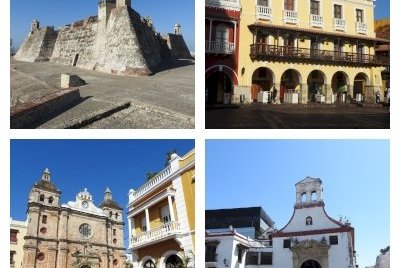
A visit to Cartagena does leave you with mixed feelings. On the one hand, it is Colombia’s most vibrant city which also has preserved its historical core. On the other hand, it is so fully geared to tourism that sooner or later you will get fed up with it, trying to fend off the stream of sellers of water and hats and avoid the ubiquitous tour groups. I had about 2 full days there, which I found a good amount of time. When you walk away a bit from the clock tower area and the busiest parts of the historic center, it certainly gets enjoyable. The city also has an accessible and low-key airport with long-haul connections, for example to Amsterdam, New York and Lima.
The town’s OUV mostly is about its military fortresses and port. So on my first morning in the city I walked via the bridge from the center to the big fort on the other side of the bay. The Fort San Felipe de Barajas opens at 8 a.m. and I was one of the first visitors of the day, so it was very quiet. It is a fort built by the Spaniards in 1536, intended to expel the English from the Colombian coast.
Reportedly, it is the largest fort in South America. But only a small part dates from the 16th century, in the 17th and 18th centuries the structure was significantly enlarged to the large, bulky mass that it is now. There …
Keep reading 0 comments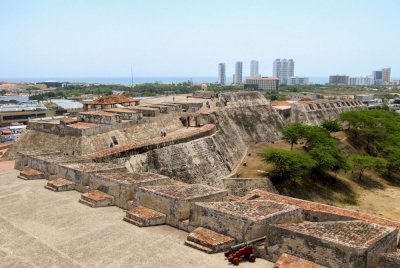
After reading many travel reviews on Cartagena suggesting that less time is better (cost, crowds and hassle were frequently mentioned) we only gave ourselves one full day to see the old town. The highlights can certainly be seen in a busy day but I felt rushed and didn't do all that I'd hoped.
As a strategic Caribbean port for the colonial Spaniards, Cartagena was wealthy and needed protection. A lot of protection. Inscribed as the largest system of military fortifications in South America there are a lot of forts surrounding the bay/port and the wall surrounding the colonial core is still intact and good for strolling as well. We started with a visit to the massive Castillo de San Felipe, the largest and most important of the forts before venturing into the colonial core. Within, the centre is well preserved and densely packed with narrow streets and more traffic than it needs to have. Maybe it is obvious because of its location but the overall feel is much more Caribbean than South American. Think Havana, not Lima.
We were lucky and didn't have any cruise ships unloading hoards of tourists to overwhelm the centre but it still felt busy and there is no doubt this is the most visited city in Colombia. Trips into the bay or out to nearby islands should give a better perspective of the overall defensive strategy but we didn't have time. I was happy to have gotten a window seat on our flight …
Keep reading 0 comments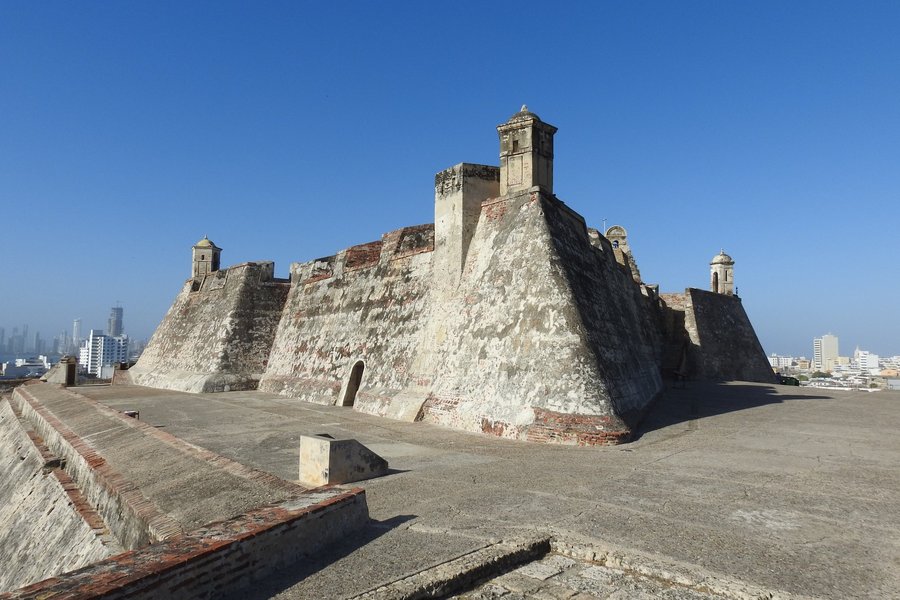
The day we arrived in Cartagena (Nov. 2010) it was pouring rain. The streets were flooded, traffic was backed up and it was hard to get around. Nevertheless, it was nice to be there during the rainstorm because we saw a unique side of the city. When it rains, the water comes off of the fort in large, cascading waterfalls. Whether that was by design or merely water finding any open outlet, it created a unique and interesting view. The local children gathered under these waterfalls to play and bathe. The old town area wasn't flooded and we spent some time exploring that area, too. The rain also meant that not as many tourists were there and that there were fewer street vendors competing for our attention (although several enterprising ones were selling umbrellas).
Keep reading 0 comments
We visited Cartegena in the spring of 2009 and took a harbor cruise. We were able to see how the Spanish organized the 8 forts defensively to protect against pirate attacks. The view of the city's skyline in fantastic! We saw the spires of cathedrals outlined against a pristine, blue sky. We could see the building of modern skyscrapers being constructed. And, most impressively, the size of the bay. It is immense! No wonder Cartegena has been an important port for centuries.
Keep reading 0 comments
Cartagena is a port city known for its giant fort. Think old town San Juan, Puerto Rico or Campeche, Mexico only bigger. The town is extremely well preserved and receives few tourists most likely because of Colombia's violent drug trafficking.
The clean and tidy town is dominated by a huge, well preserved stone fort that can be explored from top to bottom. The streets beneath the fort are a cobbled jumble of colorful two story homes and shops. An elevated promenade along the water (appears to be a built up sea wall) allows you to see all over the historic centre. Spanish colonial architecture influence is evident throughout the old part of the city.
Cartagena contains some beautifully preserved churches and convents in the hills above the town as well as the requisite spanish baroque style cathedral in the city centre.
Cartagena also has some areas that are not tourist friendly but it is generally safe. You need to speak at least a bit of spanish though for an enjoyable visit. Prices are dirt cheap!!
Keep reading 0 comments
